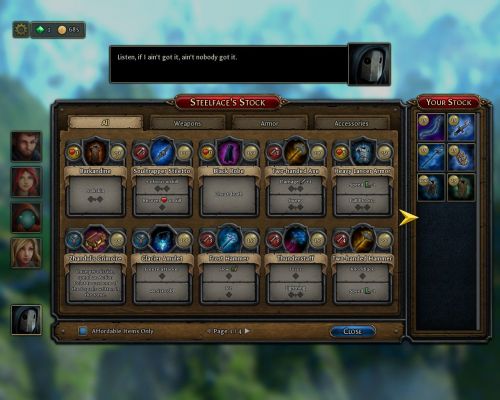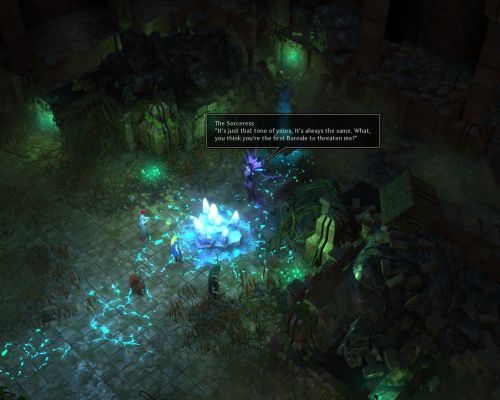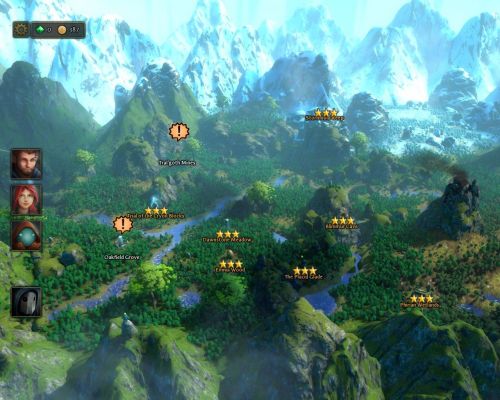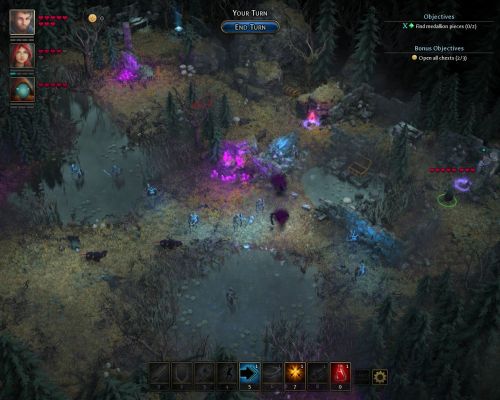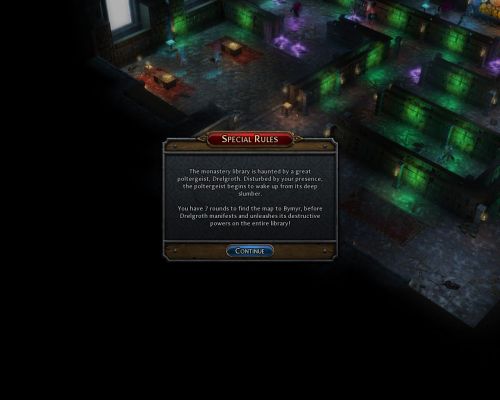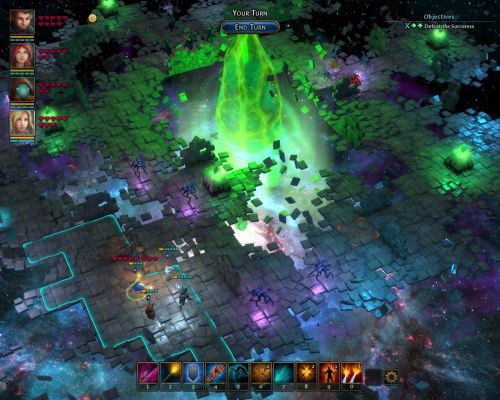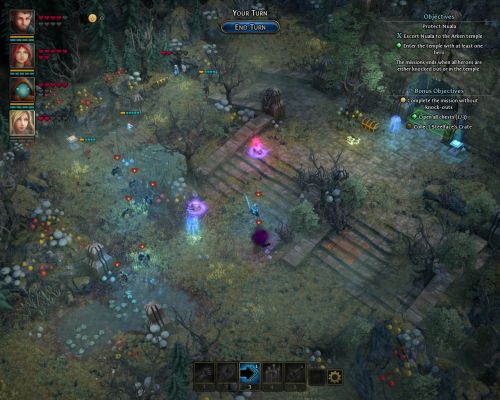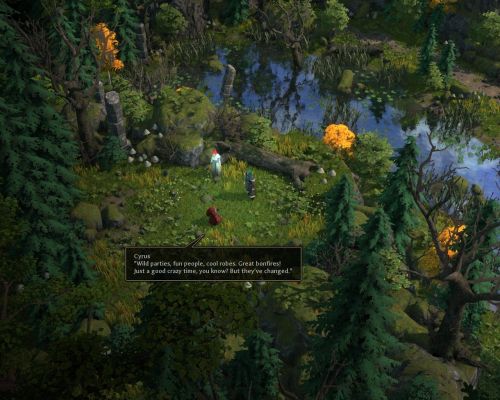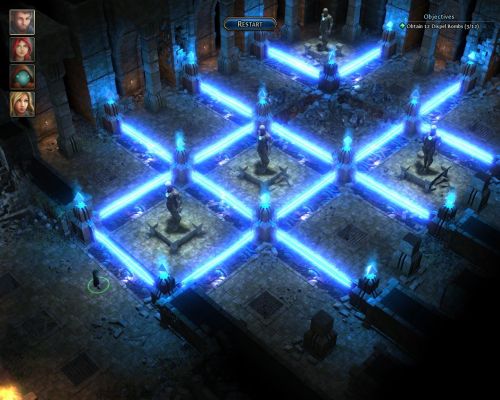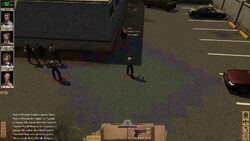RPG Codex Review: Druidstone
RPG Codex Review: Druidstone
Codex Review - posted by Infinitron on Sat 29 June 2019, 20:17:16
Tags: Ctrl Alt Ninja; Druidstone: The Secret of the Menhir Forest[Review by Darth Roxor]
Druidstone: The Secret of the Menhir Forest
Much glee was had in 2017 when Druidstone was announced. After a long radio silence, the people who made Legend of Grimrock were gearing up for a new game? Sign me up! The details of this new endeavour were a bit murky though, and as time went by, new updates on the development blog introduced some confusion.
For starters, Druidstone wasn’t being made by Almost Human, the LoG devs, per se – it was a side project of sorts by a few members of the studio, reformed under the name of “Ctrl Alt Ninja”. But that wasn’t all that important compared to the fundamental design changes the game seemed to have been going through.
In the announcement, the developers presented it as an open world, procedurally generated RPG with roguelike elements. Then some time later all of that was apparently thrown out the window, and Druidstone transformed into a mission-based tactical RPG that eschewed any and all randomness. And finally in 2019 it was released. Let us inspect whether the game’s quality and other values didn’t suffer from this development rollercoaster.
Forestdruid: The Stone of the Secret Menhir
As you might expect from a “tactical RPG”, Druidstone is a party-based game. You start with three characters and eventually get a fourth one to join the posse, though you have no influence over their general looks and archetypes. All of them are pre-generated, and the only things you get to customise for them at the start are their names, though that doesn’t mean you don’t have a degree of freedom in how you want to develop them down the line. But first things first.
The character system is so basic, there’s hardly anything to say about it. Statistics are limited to “Health” (how much damage you can take before getting KO’d), “Armour” (flat damage reduction), “Speed” (movement range) and “Damage” (basic attack damage value). And that’s it. There’s nothing else when it comes to stats. Plus, they don’t even rise by themselves as you level up – all of them are influenced solely by your gear and individual abilities, which constitute Druidstone’s only real measure of character development.
Items are divided into weapons, armour and accessories, and most of these have character-related restrictions (such as no magic staves for the fighter, the usual). Weapons have flat damage, some innate special abilities and come in one- and two-handed variants, which means you can take two single-handers into battle if you want to switch between both of them on the go. Armour usually has a flat health bonus and gives tactical bonuses such as immunity to getting slowed or frozen. Accessories give a variety of different boons that are too numerous to cover – they can give you more speed, longer range on abilities, summon reinforcements, etc. Sometimes the items also carry penalties, like a twig vest that makes the wearer suffer more damage from fire attacks.
You never find or loot items for free as you play, they always have to be bought from a convenient weapons shoppe. Quite obviously, the more an item costs, the more useful it is, so gear progression is rather clear, though it still leaves you with some degree of customisation. Still, many of the items feel gratuitous rather than necessary, especially the accessories, so be prepared to buy stuff only because you have nothing left to do with your gold (though buying gear is the sole purpose of money, so…). One stinker here is that sometimes, though very rarely, it isn’t inherently obvious what an item does, so you might be buying a cat in the bag. Two examples I noted down were boots granting lightning immunity that nevertheless couldn’t protect you from the ranged “shock” attack of a giant jellyfish; or others that let a character “walk through traps without triggering them”, even though I can’t for the life of me remember any traps in this game.
Abilities are the real meat on your heroes’ bones though. These are all actions more involved than moving around and smacking things, but they also include passive buffs like a permanent increase in speed or armour. When a hero levels up, you get to choose one ability from 2-3 available options, though an ability you don’t pick here isn’t discarded, since you can choose it again on a new level up. A character can have a total of 12 abilities active at a time (not counting those gained from items), and since they start with a couple, you’ll max out your skill roster around level 8, well before the end of the game. After that you can still pick new abilities on level up and swap them in or out as you see fit.
The final, and perhaps most important part, of the character system are power gems. They are basically upgrade points gained as you progress through the game, and they can be inserted into both items and abilities to give them new properties. Stick two into a sword to gain +1 damage. Put a bunch into a fireball spell to get one additional use of the skill per gem in every mission. Some gem placements can even unlock new skills of their own, like a multi-shot ability for a bow. The neat thing about this system is that, like with abilities, you can swap the gems in and out between missions as you like, meaning you can adapt to new challenges as you encounter them. Mixing and matching gems and abilities to get an appropriately overpowered combo can be both fun and rewarding as well.
Now to return to our heroes. They make for a fairly standard and self-explanatory roster of RPG smiters of evil.
First is the warrior guy. He’s your go-to man for hitting things in the face or stopping the enemies from doing that to your dudes. His ability selection lets you develop him both as a heavy hitter or a roadblock, though he’s much more effective as the former.
Next we have the archer gal. Though she’s not really much of an archer, as the bulk of her abilities are support spells like heals, revives, armour buffs, etc. This automatically makes her the least useful character of the bunch because you could argue her skills become needed only when you screw up. And while you can do some neat tricks with her bow down the line, it always feels like she’s underperforming.
Third is a gnome-like wizard fellow. He’s by far the most important character in the game, since the multiple area damage spells he brings to the table can let you mow down hordes of enemies with a flick of the wrist. He even has a number of support/defensive spells that make the archer gal even less useful.
The last is a ninja girl. Alright, the ninja may not be entirely standard, and she is in fact the most interesting of the bunch when it comes to her ability selection, because she’s focused on mobility and displacement – she can jump over enemies, pull them closer, push them back, all that jazz. Clever use of her skills lets you set up excellent killing zones for the rest of the party. Unfortunately, you get her very late into the game, I’d say even past the midpoint, which is a decision I can hardly understand. But so it goes.
As you can see, the character building in Druidstone is… not very advanced. It feels less like developing a party of heroes, and more like unlocking new spell cards in a card game. There’s nothing necessarily wrong with that, but I still feel like it’s much too barebones, especially if you want to call your game an RPG. You can hardly say that the characters even have statistics to begin with, since all of them are “static” and defined primarily by equipment.
But I think it’s safe to claim that the real measure of a character system is how it translates into practice.
Menhirforest: The Druid of the Stone Secret
Druidstone is structured as a campaign with primary and optional missions for you to embark on. These are available from the overland map view, where you also manage your characters. Finishing any “storyline” mission typically unlocks a number of new ones. “Old” missions never expire, and in fact even finished quests can be revisited, albeit for significantly reduced experience and gold gains.
Selecting any available mission gives you a short briefing, which is rarely very informative, and lists how many separate combat scenes or story-related vignettes it includes. All that remains is pressing the big “play” button.
Except for one line of “puzzle” levels, all the missions in Druidstone involve combat, and the basic mechanics are about as barebones as the character system. Combat takes place on square-grid maps with various objectives and enemies, and your party always starts in a pre-determined section of the level. Characters can perform one action a turn (unless it’s a free action), they can cross squares up to their speed value, running by enemies provokes attacks of opportunity, damage reduces health, zero health means death for enemies and knockout for heroes, etc. It’s all very generic and inoffensive.
Since the basic mechanics are so simple, the game primarily relies on encounter setups and character skills for entertainment. Abilities are fairly varied, and while most of them are of the damaging or damage-preventing type, there are also many that let you manipulate the battlefield to your advantage. I’ve already mentioned the pulls and pushes of the ninja character, but she’s not the only one capable of doing that – every hero can be outfitted with something that lets him reposition himself or an enemy. The wizard, for example, starts with a teleport/swap spell that has excellent utility for both offence and defence, and can also be given a wall spell that blocks off a selected square. He also shares a “focus” ability with the archer, which lets them empower a spell for a single cast to give it additional properties (usually multi-target effects).
Now, the first big thing that may have you raise an eyebrow is the fact that nearly everything about Druidstone’s mechanics is deterministic. There are no dice rolls to hit, saving throws or damage brackets to speak of. The only major exceptions to this are power-ups dropped randomly by monsters on death, which include bonus action points, health or gold, as well as the contents of chests placed on the maps. There is something incredibly weird and “arcadey” about this, especially since some of the power-ups can be downright game-changing. Having your action refreshed in a clutch moment can turn the battle upside down, while the chests provide consumable items that range from fairly lacklustre (healing potions) to insanely powerful (global protection from damage, an extra turn for all characters, bundles of TNT etc.).
Naturally, this deterministic approach has a huge influence on mission design. As everything is hand-placed and nothing in terms of the mechanics is random, Druidstone has to rely on a number of key measures to make sure that the player isn’t able to plan a successful route to victory from the very first turn. Some of them work, some are questionable, and many are quite annoying.
What works well are some of the abilities available to monsters, which can make the course of battle somewhat unpredictable, and which also make you consider your progress through a mission. These include wraiths that can resurrect dead enemies as skeletons an infinite number of times, mage-killing spiders that can steal your spells for a while, or an assortment of foes with healing spells. Obviously there’s more, and they are too many to list, since the majority of enemies have some unique quirk that gives them a specific and characteristic role on the battlefield.
Another aspect which I’d consider well done is the general way maps are structured. I’ve seen “full deterministic” tactics games before that were more or less glorified puzzlers, with only one obvious/optimal way of getting through each encounter. And while some levels in Druidstone also fall for this trap, most of them are broad or open enough to invite multiple ways of approach.
The questionable part is Druidstone’s overreliance on timers soft and hard for most of the missions. Their purpose is obvious – they are meant to force you to keep going instead of hunkering down in a corner and easily wiping all the enemies out. My problems with this approach are several. First of all, you can hardly ever tell what will happen when the doomsday countdown reaches zero – whether it’s a game over or not, whether it’ll lead to catastrophic hindrances or just a minor nuisance, etc. For example, in an early mission where you must light a few beacons on fire on a snowy map, you are informed at the start that a “frost hazard” will affect you in X turns. What this “frost hazard” entails is a complete mystery until the countdown expires, so despite the fact that you know about its coming from the beginning, there is no real way you can take it into consideration as you advance through the level.
Furthermore, I dislike how common the doomsday timers are in this game. Racing against the clock every now and again can be exciting. But when you have to do it for what feels like the majority of the game, combined with the aforementioned opaqueness, it simply becomes tiring after a point. Also, in many missions they aren’t “timers” per se, but objectives such as “stop the guy who is immune to any displacement from reaching the other side of the map”, which in essence is the same thing.
Finally, though this is the least important, it looks silly when a mission puts you up against whatever countdown and overwhelming odds, only to show your party stay around and chat in an outro cutscene once the mission is over. At one point your heroes even spend hours inside a haunted library that was supposed to unleash an angry poltergeist in X turns just a moment ago.
As for the annoying bits, there’s a lot to talk about here. Let’s start with enemy reinforcements. I don’t think there’s any level in the entire game that doesn't have them, and they are always used in a very cheap and irritating manner.
Reinforcements are typically announced one turn in advance by dropping “teleporter beacons” on certain squares. These are pre-placed, they can spawn at any moment and in any square (including right on top of your party), and you have absolutely no way of telling when, where and what they will spawn. A reasonable approach would be to adapt the spawning points to the map design somehow – like make skeletons rise out of graves or have wolves run out of dens. But Druidstone disagrees, and it keeps deep striking seemingly random enemies into seemingly random places at seemingly random intervals, while you are left scratching your head, thinking who the hell thought this was a good idea. I dare say this feature is bad from the very start and never becomes less bad. At some point you kind of learn to live with them – because they become a simple fact of life, like mosquitoes, cars freezing in the winter and AIDS – but much like the doomsday timers, eventually they grow really old, and the only reaction they get from you is “not this crap again”.
However, Druidstone likes its monster deep strikes so much that you need to watch out not only for the telegraphed ones. Monster death squads can also spawn out of nowhere on top of your party unannounced, though fortunately this doesn’t happen as often.
The unannounced monster spawns are a part of Druidstone’s number one most annoying aspect. The “gotcha!” moments. This game really, really loves to pull absolute nonsense out of its posterior, rub it all over your face and strut around, yelling “I totally fooled you!” In my experience, triggering a gotcha usually results in immediate turn rewind or even a restart of a level, because more often than not, it puts you up against a battlefield reshuffle that makes most of what you’ve done until that point moot. Typically, the gotchas are of a “bait-and-switch” variety, where accomplishing an intermediate objective suddenly unleashes all hell, in a way that you could have never predicted.
My absolutely favourite example of the above is a big bossfight against the avatar of a god of fire. The avatar is basically a time bomb – after X turns, it will explode and collapse the dungeon. Your primary objective is to escape by unlocking the exit and leading all your characters to it. But there’s also an optional objective to kill the big boss. Since he has a lot of health and quite the numerous entourage of goons, with more that keep spawning, a reasonable person would assume that killing the boss is a challenging way of winning early. Imagine my surprise when vanquishing the wicked foe made one of my characters yell (literally), “oh no, the dungeon is going to collapse anyway!” and set the countdown even lower than it was before. Needless to say, my heroes were too far away from the exit at that point. Truly, this was the gotcha of the freaking century.
This is just one example, and while it might be the biggest one barring the final boss (and I’m not gonna discuss that one), smaller ones are no less annoying. Even further, they are so plentiful that they might even form the core of Druidstone’s difficulty, and that, dear reader, is not very good at all.
That’s because not all levels stoop to this kind of ludicrous and downright unfair design. Sometimes the game does have you face a properly outlined challenge that keeps chipping away at you through attrition and clever enemy composition and placement. In times like these, Druidstone can be loads of fun, and it gets your noggin joggin’ when you analyse your every option multiple moves into the future to escape from a perilous situation. One of my favourite levels that reflects this perfectly is a mission where you have to break through an army of the undead guarding the entrance to an ancient temple, all the while protecting another weak character from harm. The map is big, it gives you a number of paths to consider, it mixes strong dark knights with a horde of cannon fodder skeletons, and also drops a few of the necromantic wraiths along the way. No gotchas, no nonsense, pure planning and attrition.
Unfortunately, just when you think you’re starting to have fun, Druidstone goes out of its way to kick you in the balls with something stupid again. And while in the final tally I’d say that the fun-to-bullshit ratio is roughly 50/50, bullshit is much more aggravating by its very nature.
However, your frustration will vary depending on how many objectives you decide to satisfy during missions. Obviously, any self-respecting gentleman will go after all of them, especially since otherwise the missions would be laughably easy. Main objectives can typically be finished fast and without major complications, but side objectives often require you to run around the entire map in search of stuff, which means exposing yourself a lot more to the doomsday counters and endless reinforcements. It’s usually worth it to go after them, though, because their rewards can include power gems or new item selections in the shop.
Speaking of objectives, for better or for worse, Druidstone avoids “kill ‘em all” missions, and usually aims to put you against something more “elaborate”. This can include escort missions, “hit x hotspots around the map”, high-value target assassinations, the usual. There’s no rule to define which work better and which worse, because ultimately most depends on the map in question and the details of the quest. So while one escort mission can be fun (like the undead temple I outlined above), another one can be abysmal (like pushing an NPC who doesn’t move on his own to the other side of the map). In the long run, you might sometimes miss the “kill ‘em all”.
Side objectives also vary, but usually they force you to take a detour of some sort. Sometimes they can be rather abstract, like opening all the chests on a map (why doesn’t the party do that after all is done?), or more down to earth, like killing a group of strong enemies.
Objectives and general gameplay are also influenced a lot by the game’s difficulty settings. Druidstone has three difficulty levels: easy, medium and hard. The differences between them are fairly significant, since they seem to affect everything this game has to offer. Mind you, I’ve only given them a cursory glance, since I played through Druidstone exclusively on hard, but all three exhibit differences in monster stats, doomsday timer durations and how many enemies are spawned on a map. But I cannot tell whether they also change the monster reinforcements or AI in any way. At least in the case of AI, I don’t think they’d have too much leeway here, since it’s just functional and not much else. In my experience, enemies never do anything particularly dumb, but they also aren’t exactly strategic geniuses.
To close this chapter, I suppose I could also say a few things about the story and such. It’s better to keep this short, though.
In general, Druidstone’s story is completely skippable, and in fact you’d be wise to fast-forward through all the dialogues and cutscenes, because they feel like they were written by a twelve-year-old. The writing was probably intended to be funny and zany, but instead ended up juvenile and stupid. The characters of this genericfantasylandia keep talking like modern teenagers (e.g. by referring to things as “wicked awesome” etc.), everything is largely forgettable and derivative, and there are also a few awkward attempts at breaking the fourth wall. The chief of this is probably the ninja girl, who is actually Japanese, and whose consciousness is yanked from another world and swapped with that of another NPC. We’ve come very far from the subtlety of Legend of Grimrock indeed.
The storyline is also more or less generic fantasy tripe about an Evil Sorceress™ who corrupts the Ancient Forest™ of the Mysterious Druids™, yadda yadda yadda. What deserves special attention, though, is the way it transforms into a carbon copy of Diablo 2: Lord of Destruction around the end. The game’s finale has you fight an arachnoid demon that taps into a worldstone (yep, it’s even called the worldstone) to gain Ultimate Power™. You kill the demon, but it turns out the worldstone is too corrupted and has to be destroyed, so that the world may be reborn. Sounds familiar?
Secretmenhir: The Forest of the Druid Stone
When you consider the game’s presentation, both in terms of video and audio, you quickly come to the conclusion that the budget for Druidstone must have been roughly 200 US Dollars and four crates of vodka. There’s not much to say about the graphics other than the fact that they look like they’ve been shifted from a mobile game, and that some of the environmental assets appear to be recycled from Legend of Grimrock. There’s nothing inherently bad about recycling, in fact I always applaud it, but textures that are meant to look good up close naturally lose a lot of their merits when viewed from an isometric perspective.
Sounds for the most part are also unobtrusive and unremarkable. Except the music, which at times feels as misplaced as the writing, since it includes both typical fantasy tunes with flutes and fiddles, and weirdo songs with overdriven guitars and drum solos. It’s a bit jarring at first, but I can’t deny that some of the high-tempo tracks fit well and get you pumping through the crazier missions.
The UI also looks like someone lifted it from a mobile game, but it must be said that it’s made with a lot of convenience in mind for a game of this kind. In turn-based tactics games, I always run into problems when it comes to calculating line of sight – but this never happened to me in Druidstone. Character movement grids, ability ranges, lines of sight and a few other, more specific things are very, very well presented, and even if you happen to miscalculate something or missclick, there’s a handy and wonderful “undo move” button, which reverts a character’s turn as long as he hasn’t used an action. The archer gal also has a full turn rewind ability, but it’s limited to one use per mission, and you’d be wise to hold on to it to prevent gotchas from ruining your day.
Still, a few things when it comes to the mechanics could use just a bit more explanation. At the start you can’t really tell what some things mean or do outside trial and error, and in a game where every move counts, this can cost you a lot. For example, some enemies have nasty abilities that you can hardly prepare against when facing them for the first time. And while I don’t think the player should be given absolutely all information about a given monster, I do believe it would be nice to at least allude somehow to the fact that a fire elemental enemy will explode on death. Especially in a mission with a side objective to avoid any knockouts. Gotcha!
Stonesecret: The Menhir of the Forest Druid
What is left to say? Druidstone is a weird game. The basic mechanics, general low-budget feel and hodgepodge of barely matching elements make it look like it was glued together in half a year. At roughly 20 hours of gameplay, it’s also fairly short. I can only assume all of this is the legacy of the constant design changes mentioned in the introduction.
At the same time, it feels and plays a lot like a board game of sorts – it’s definitely not an RPG, and not even a simulacrum of a pen and paper RPG. When you think about it, board games also tend to have simple mechanics and structures, which are offset by handcrafted challenges and rivalry between either the players themselves or the players and the local equivalent of a game master. Druidstone fits this to a T, except for one thing – the GM is a sadistic maniac, who in a real life situation would get yelled at after three encounters tops, and would be forced to make his missions more reasonable or the players would just desert him.
Also, as you may have noticed, I refrained from making any comparisons of Druidstone to Grimrock. This is because the two games are so different in every single aspect, any comparisons would be pointless at best, and let’s not forget that this is technically the work of a different studio, not Almost Human. A better point of comparison, which I’ve seen made before on this very site, would probably be Daedalic’s Blackguards. And Druidstone doesn’t fare well in this matchup. Compared to Blackguards, this game lacks a lot of the “naturalness” of combat encounters (since every map must have a gimmick-driven objective) as well as much of the freedom of approach and character development that should be a big part of any roleplaying game.
Finally, though some of the missions are undeniably fun, each one is outweighed by others that are anything but. Druidstone may look like a promising effort when you look at some of the bits and pieces, but recalling the annoyances and frustration I had to go through when playing it, I don’t think it’s something I could honestly recommend – the good bits are simply not worth the pain required to reach them.
Druidstone: The Secret of the Menhir Forest
Much glee was had in 2017 when Druidstone was announced. After a long radio silence, the people who made Legend of Grimrock were gearing up for a new game? Sign me up! The details of this new endeavour were a bit murky though, and as time went by, new updates on the development blog introduced some confusion.
For starters, Druidstone wasn’t being made by Almost Human, the LoG devs, per se – it was a side project of sorts by a few members of the studio, reformed under the name of “Ctrl Alt Ninja”. But that wasn’t all that important compared to the fundamental design changes the game seemed to have been going through.
In the announcement, the developers presented it as an open world, procedurally generated RPG with roguelike elements. Then some time later all of that was apparently thrown out the window, and Druidstone transformed into a mission-based tactical RPG that eschewed any and all randomness. And finally in 2019 it was released. Let us inspect whether the game’s quality and other values didn’t suffer from this development rollercoaster.
Forestdruid: The Stone of the Secret Menhir
As you might expect from a “tactical RPG”, Druidstone is a party-based game. You start with three characters and eventually get a fourth one to join the posse, though you have no influence over their general looks and archetypes. All of them are pre-generated, and the only things you get to customise for them at the start are their names, though that doesn’t mean you don’t have a degree of freedom in how you want to develop them down the line. But first things first.
The character system is so basic, there’s hardly anything to say about it. Statistics are limited to “Health” (how much damage you can take before getting KO’d), “Armour” (flat damage reduction), “Speed” (movement range) and “Damage” (basic attack damage value). And that’s it. There’s nothing else when it comes to stats. Plus, they don’t even rise by themselves as you level up – all of them are influenced solely by your gear and individual abilities, which constitute Druidstone’s only real measure of character development.
Items are divided into weapons, armour and accessories, and most of these have character-related restrictions (such as no magic staves for the fighter, the usual). Weapons have flat damage, some innate special abilities and come in one- and two-handed variants, which means you can take two single-handers into battle if you want to switch between both of them on the go. Armour usually has a flat health bonus and gives tactical bonuses such as immunity to getting slowed or frozen. Accessories give a variety of different boons that are too numerous to cover – they can give you more speed, longer range on abilities, summon reinforcements, etc. Sometimes the items also carry penalties, like a twig vest that makes the wearer suffer more damage from fire attacks.
You never find or loot items for free as you play, they always have to be bought from a convenient weapons shoppe. Quite obviously, the more an item costs, the more useful it is, so gear progression is rather clear, though it still leaves you with some degree of customisation. Still, many of the items feel gratuitous rather than necessary, especially the accessories, so be prepared to buy stuff only because you have nothing left to do with your gold (though buying gear is the sole purpose of money, so…). One stinker here is that sometimes, though very rarely, it isn’t inherently obvious what an item does, so you might be buying a cat in the bag. Two examples I noted down were boots granting lightning immunity that nevertheless couldn’t protect you from the ranged “shock” attack of a giant jellyfish; or others that let a character “walk through traps without triggering them”, even though I can’t for the life of me remember any traps in this game.
Abilities are the real meat on your heroes’ bones though. These are all actions more involved than moving around and smacking things, but they also include passive buffs like a permanent increase in speed or armour. When a hero levels up, you get to choose one ability from 2-3 available options, though an ability you don’t pick here isn’t discarded, since you can choose it again on a new level up. A character can have a total of 12 abilities active at a time (not counting those gained from items), and since they start with a couple, you’ll max out your skill roster around level 8, well before the end of the game. After that you can still pick new abilities on level up and swap them in or out as you see fit.
The final, and perhaps most important part, of the character system are power gems. They are basically upgrade points gained as you progress through the game, and they can be inserted into both items and abilities to give them new properties. Stick two into a sword to gain +1 damage. Put a bunch into a fireball spell to get one additional use of the skill per gem in every mission. Some gem placements can even unlock new skills of their own, like a multi-shot ability for a bow. The neat thing about this system is that, like with abilities, you can swap the gems in and out between missions as you like, meaning you can adapt to new challenges as you encounter them. Mixing and matching gems and abilities to get an appropriately overpowered combo can be both fun and rewarding as well.
Now to return to our heroes. They make for a fairly standard and self-explanatory roster of RPG smiters of evil.
First is the warrior guy. He’s your go-to man for hitting things in the face or stopping the enemies from doing that to your dudes. His ability selection lets you develop him both as a heavy hitter or a roadblock, though he’s much more effective as the former.
Next we have the archer gal. Though she’s not really much of an archer, as the bulk of her abilities are support spells like heals, revives, armour buffs, etc. This automatically makes her the least useful character of the bunch because you could argue her skills become needed only when you screw up. And while you can do some neat tricks with her bow down the line, it always feels like she’s underperforming.
Third is a gnome-like wizard fellow. He’s by far the most important character in the game, since the multiple area damage spells he brings to the table can let you mow down hordes of enemies with a flick of the wrist. He even has a number of support/defensive spells that make the archer gal even less useful.
The last is a ninja girl. Alright, the ninja may not be entirely standard, and she is in fact the most interesting of the bunch when it comes to her ability selection, because she’s focused on mobility and displacement – she can jump over enemies, pull them closer, push them back, all that jazz. Clever use of her skills lets you set up excellent killing zones for the rest of the party. Unfortunately, you get her very late into the game, I’d say even past the midpoint, which is a decision I can hardly understand. But so it goes.
As you can see, the character building in Druidstone is… not very advanced. It feels less like developing a party of heroes, and more like unlocking new spell cards in a card game. There’s nothing necessarily wrong with that, but I still feel like it’s much too barebones, especially if you want to call your game an RPG. You can hardly say that the characters even have statistics to begin with, since all of them are “static” and defined primarily by equipment.
But I think it’s safe to claim that the real measure of a character system is how it translates into practice.
Menhirforest: The Druid of the Stone Secret
Druidstone is structured as a campaign with primary and optional missions for you to embark on. These are available from the overland map view, where you also manage your characters. Finishing any “storyline” mission typically unlocks a number of new ones. “Old” missions never expire, and in fact even finished quests can be revisited, albeit for significantly reduced experience and gold gains.
Selecting any available mission gives you a short briefing, which is rarely very informative, and lists how many separate combat scenes or story-related vignettes it includes. All that remains is pressing the big “play” button.
Except for one line of “puzzle” levels, all the missions in Druidstone involve combat, and the basic mechanics are about as barebones as the character system. Combat takes place on square-grid maps with various objectives and enemies, and your party always starts in a pre-determined section of the level. Characters can perform one action a turn (unless it’s a free action), they can cross squares up to their speed value, running by enemies provokes attacks of opportunity, damage reduces health, zero health means death for enemies and knockout for heroes, etc. It’s all very generic and inoffensive.
Since the basic mechanics are so simple, the game primarily relies on encounter setups and character skills for entertainment. Abilities are fairly varied, and while most of them are of the damaging or damage-preventing type, there are also many that let you manipulate the battlefield to your advantage. I’ve already mentioned the pulls and pushes of the ninja character, but she’s not the only one capable of doing that – every hero can be outfitted with something that lets him reposition himself or an enemy. The wizard, for example, starts with a teleport/swap spell that has excellent utility for both offence and defence, and can also be given a wall spell that blocks off a selected square. He also shares a “focus” ability with the archer, which lets them empower a spell for a single cast to give it additional properties (usually multi-target effects).
Now, the first big thing that may have you raise an eyebrow is the fact that nearly everything about Druidstone’s mechanics is deterministic. There are no dice rolls to hit, saving throws or damage brackets to speak of. The only major exceptions to this are power-ups dropped randomly by monsters on death, which include bonus action points, health or gold, as well as the contents of chests placed on the maps. There is something incredibly weird and “arcadey” about this, especially since some of the power-ups can be downright game-changing. Having your action refreshed in a clutch moment can turn the battle upside down, while the chests provide consumable items that range from fairly lacklustre (healing potions) to insanely powerful (global protection from damage, an extra turn for all characters, bundles of TNT etc.).
Naturally, this deterministic approach has a huge influence on mission design. As everything is hand-placed and nothing in terms of the mechanics is random, Druidstone has to rely on a number of key measures to make sure that the player isn’t able to plan a successful route to victory from the very first turn. Some of them work, some are questionable, and many are quite annoying.
What works well are some of the abilities available to monsters, which can make the course of battle somewhat unpredictable, and which also make you consider your progress through a mission. These include wraiths that can resurrect dead enemies as skeletons an infinite number of times, mage-killing spiders that can steal your spells for a while, or an assortment of foes with healing spells. Obviously there’s more, and they are too many to list, since the majority of enemies have some unique quirk that gives them a specific and characteristic role on the battlefield.
Another aspect which I’d consider well done is the general way maps are structured. I’ve seen “full deterministic” tactics games before that were more or less glorified puzzlers, with only one obvious/optimal way of getting through each encounter. And while some levels in Druidstone also fall for this trap, most of them are broad or open enough to invite multiple ways of approach.
The questionable part is Druidstone’s overreliance on timers soft and hard for most of the missions. Their purpose is obvious – they are meant to force you to keep going instead of hunkering down in a corner and easily wiping all the enemies out. My problems with this approach are several. First of all, you can hardly ever tell what will happen when the doomsday countdown reaches zero – whether it’s a game over or not, whether it’ll lead to catastrophic hindrances or just a minor nuisance, etc. For example, in an early mission where you must light a few beacons on fire on a snowy map, you are informed at the start that a “frost hazard” will affect you in X turns. What this “frost hazard” entails is a complete mystery until the countdown expires, so despite the fact that you know about its coming from the beginning, there is no real way you can take it into consideration as you advance through the level.
Furthermore, I dislike how common the doomsday timers are in this game. Racing against the clock every now and again can be exciting. But when you have to do it for what feels like the majority of the game, combined with the aforementioned opaqueness, it simply becomes tiring after a point. Also, in many missions they aren’t “timers” per se, but objectives such as “stop the guy who is immune to any displacement from reaching the other side of the map”, which in essence is the same thing.
Finally, though this is the least important, it looks silly when a mission puts you up against whatever countdown and overwhelming odds, only to show your party stay around and chat in an outro cutscene once the mission is over. At one point your heroes even spend hours inside a haunted library that was supposed to unleash an angry poltergeist in X turns just a moment ago.
As for the annoying bits, there’s a lot to talk about here. Let’s start with enemy reinforcements. I don’t think there’s any level in the entire game that doesn't have them, and they are always used in a very cheap and irritating manner.
Reinforcements are typically announced one turn in advance by dropping “teleporter beacons” on certain squares. These are pre-placed, they can spawn at any moment and in any square (including right on top of your party), and you have absolutely no way of telling when, where and what they will spawn. A reasonable approach would be to adapt the spawning points to the map design somehow – like make skeletons rise out of graves or have wolves run out of dens. But Druidstone disagrees, and it keeps deep striking seemingly random enemies into seemingly random places at seemingly random intervals, while you are left scratching your head, thinking who the hell thought this was a good idea. I dare say this feature is bad from the very start and never becomes less bad. At some point you kind of learn to live with them – because they become a simple fact of life, like mosquitoes, cars freezing in the winter and AIDS – but much like the doomsday timers, eventually they grow really old, and the only reaction they get from you is “not this crap again”.
However, Druidstone likes its monster deep strikes so much that you need to watch out not only for the telegraphed ones. Monster death squads can also spawn out of nowhere on top of your party unannounced, though fortunately this doesn’t happen as often.
The unannounced monster spawns are a part of Druidstone’s number one most annoying aspect. The “gotcha!” moments. This game really, really loves to pull absolute nonsense out of its posterior, rub it all over your face and strut around, yelling “I totally fooled you!” In my experience, triggering a gotcha usually results in immediate turn rewind or even a restart of a level, because more often than not, it puts you up against a battlefield reshuffle that makes most of what you’ve done until that point moot. Typically, the gotchas are of a “bait-and-switch” variety, where accomplishing an intermediate objective suddenly unleashes all hell, in a way that you could have never predicted.
My absolutely favourite example of the above is a big bossfight against the avatar of a god of fire. The avatar is basically a time bomb – after X turns, it will explode and collapse the dungeon. Your primary objective is to escape by unlocking the exit and leading all your characters to it. But there’s also an optional objective to kill the big boss. Since he has a lot of health and quite the numerous entourage of goons, with more that keep spawning, a reasonable person would assume that killing the boss is a challenging way of winning early. Imagine my surprise when vanquishing the wicked foe made one of my characters yell (literally), “oh no, the dungeon is going to collapse anyway!” and set the countdown even lower than it was before. Needless to say, my heroes were too far away from the exit at that point. Truly, this was the gotcha of the freaking century.
This is just one example, and while it might be the biggest one barring the final boss (and I’m not gonna discuss that one), smaller ones are no less annoying. Even further, they are so plentiful that they might even form the core of Druidstone’s difficulty, and that, dear reader, is not very good at all.
That’s because not all levels stoop to this kind of ludicrous and downright unfair design. Sometimes the game does have you face a properly outlined challenge that keeps chipping away at you through attrition and clever enemy composition and placement. In times like these, Druidstone can be loads of fun, and it gets your noggin joggin’ when you analyse your every option multiple moves into the future to escape from a perilous situation. One of my favourite levels that reflects this perfectly is a mission where you have to break through an army of the undead guarding the entrance to an ancient temple, all the while protecting another weak character from harm. The map is big, it gives you a number of paths to consider, it mixes strong dark knights with a horde of cannon fodder skeletons, and also drops a few of the necromantic wraiths along the way. No gotchas, no nonsense, pure planning and attrition.
Unfortunately, just when you think you’re starting to have fun, Druidstone goes out of its way to kick you in the balls with something stupid again. And while in the final tally I’d say that the fun-to-bullshit ratio is roughly 50/50, bullshit is much more aggravating by its very nature.
However, your frustration will vary depending on how many objectives you decide to satisfy during missions. Obviously, any self-respecting gentleman will go after all of them, especially since otherwise the missions would be laughably easy. Main objectives can typically be finished fast and without major complications, but side objectives often require you to run around the entire map in search of stuff, which means exposing yourself a lot more to the doomsday counters and endless reinforcements. It’s usually worth it to go after them, though, because their rewards can include power gems or new item selections in the shop.
Speaking of objectives, for better or for worse, Druidstone avoids “kill ‘em all” missions, and usually aims to put you against something more “elaborate”. This can include escort missions, “hit x hotspots around the map”, high-value target assassinations, the usual. There’s no rule to define which work better and which worse, because ultimately most depends on the map in question and the details of the quest. So while one escort mission can be fun (like the undead temple I outlined above), another one can be abysmal (like pushing an NPC who doesn’t move on his own to the other side of the map). In the long run, you might sometimes miss the “kill ‘em all”.
Side objectives also vary, but usually they force you to take a detour of some sort. Sometimes they can be rather abstract, like opening all the chests on a map (why doesn’t the party do that after all is done?), or more down to earth, like killing a group of strong enemies.
Objectives and general gameplay are also influenced a lot by the game’s difficulty settings. Druidstone has three difficulty levels: easy, medium and hard. The differences between them are fairly significant, since they seem to affect everything this game has to offer. Mind you, I’ve only given them a cursory glance, since I played through Druidstone exclusively on hard, but all three exhibit differences in monster stats, doomsday timer durations and how many enemies are spawned on a map. But I cannot tell whether they also change the monster reinforcements or AI in any way. At least in the case of AI, I don’t think they’d have too much leeway here, since it’s just functional and not much else. In my experience, enemies never do anything particularly dumb, but they also aren’t exactly strategic geniuses.
To close this chapter, I suppose I could also say a few things about the story and such. It’s better to keep this short, though.
In general, Druidstone’s story is completely skippable, and in fact you’d be wise to fast-forward through all the dialogues and cutscenes, because they feel like they were written by a twelve-year-old. The writing was probably intended to be funny and zany, but instead ended up juvenile and stupid. The characters of this genericfantasylandia keep talking like modern teenagers (e.g. by referring to things as “wicked awesome” etc.), everything is largely forgettable and derivative, and there are also a few awkward attempts at breaking the fourth wall. The chief of this is probably the ninja girl, who is actually Japanese, and whose consciousness is yanked from another world and swapped with that of another NPC. We’ve come very far from the subtlety of Legend of Grimrock indeed.
The storyline is also more or less generic fantasy tripe about an Evil Sorceress™ who corrupts the Ancient Forest™ of the Mysterious Druids™, yadda yadda yadda. What deserves special attention, though, is the way it transforms into a carbon copy of Diablo 2: Lord of Destruction around the end. The game’s finale has you fight an arachnoid demon that taps into a worldstone (yep, it’s even called the worldstone) to gain Ultimate Power™. You kill the demon, but it turns out the worldstone is too corrupted and has to be destroyed, so that the world may be reborn. Sounds familiar?
Secretmenhir: The Forest of the Druid Stone
When you consider the game’s presentation, both in terms of video and audio, you quickly come to the conclusion that the budget for Druidstone must have been roughly 200 US Dollars and four crates of vodka. There’s not much to say about the graphics other than the fact that they look like they’ve been shifted from a mobile game, and that some of the environmental assets appear to be recycled from Legend of Grimrock. There’s nothing inherently bad about recycling, in fact I always applaud it, but textures that are meant to look good up close naturally lose a lot of their merits when viewed from an isometric perspective.
Sounds for the most part are also unobtrusive and unremarkable. Except the music, which at times feels as misplaced as the writing, since it includes both typical fantasy tunes with flutes and fiddles, and weirdo songs with overdriven guitars and drum solos. It’s a bit jarring at first, but I can’t deny that some of the high-tempo tracks fit well and get you pumping through the crazier missions.
The UI also looks like someone lifted it from a mobile game, but it must be said that it’s made with a lot of convenience in mind for a game of this kind. In turn-based tactics games, I always run into problems when it comes to calculating line of sight – but this never happened to me in Druidstone. Character movement grids, ability ranges, lines of sight and a few other, more specific things are very, very well presented, and even if you happen to miscalculate something or missclick, there’s a handy and wonderful “undo move” button, which reverts a character’s turn as long as he hasn’t used an action. The archer gal also has a full turn rewind ability, but it’s limited to one use per mission, and you’d be wise to hold on to it to prevent gotchas from ruining your day.
Still, a few things when it comes to the mechanics could use just a bit more explanation. At the start you can’t really tell what some things mean or do outside trial and error, and in a game where every move counts, this can cost you a lot. For example, some enemies have nasty abilities that you can hardly prepare against when facing them for the first time. And while I don’t think the player should be given absolutely all information about a given monster, I do believe it would be nice to at least allude somehow to the fact that a fire elemental enemy will explode on death. Especially in a mission with a side objective to avoid any knockouts. Gotcha!
Stonesecret: The Menhir of the Forest Druid
What is left to say? Druidstone is a weird game. The basic mechanics, general low-budget feel and hodgepodge of barely matching elements make it look like it was glued together in half a year. At roughly 20 hours of gameplay, it’s also fairly short. I can only assume all of this is the legacy of the constant design changes mentioned in the introduction.
At the same time, it feels and plays a lot like a board game of sorts – it’s definitely not an RPG, and not even a simulacrum of a pen and paper RPG. When you think about it, board games also tend to have simple mechanics and structures, which are offset by handcrafted challenges and rivalry between either the players themselves or the players and the local equivalent of a game master. Druidstone fits this to a T, except for one thing – the GM is a sadistic maniac, who in a real life situation would get yelled at after three encounters tops, and would be forced to make his missions more reasonable or the players would just desert him.
Also, as you may have noticed, I refrained from making any comparisons of Druidstone to Grimrock. This is because the two games are so different in every single aspect, any comparisons would be pointless at best, and let’s not forget that this is technically the work of a different studio, not Almost Human. A better point of comparison, which I’ve seen made before on this very site, would probably be Daedalic’s Blackguards. And Druidstone doesn’t fare well in this matchup. Compared to Blackguards, this game lacks a lot of the “naturalness” of combat encounters (since every map must have a gimmick-driven objective) as well as much of the freedom of approach and character development that should be a big part of any roleplaying game.
Finally, though some of the missions are undeniably fun, each one is outweighed by others that are anything but. Druidstone may look like a promising effort when you look at some of the bits and pieces, but recalling the annoyances and frustration I had to go through when playing it, I don’t think it’s something I could honestly recommend – the good bits are simply not worth the pain required to reach them.





